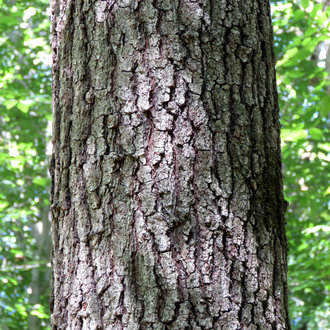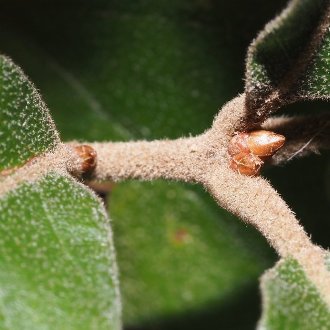Northern Red Oak vs Southern Red Oak
This guide is under construction and has not been published yet. It may have errors. When in doubt, double-check other sources for definitive ID.Where their ranges overlap, northern and southern red oak are usually relatively easy to tell apart by leaf shape, and they also have major differences in pubescence of leaves and twigs, as well as bark. They can overlap somewhat in habitat, although northern red oak prefers richer woods whereas southern red oak prefers more open woodlands and drier, sandier soils.
Northern Red Oak (Quercus rubra) | Southern Red Oak (Quercus falcata) |
A large tree, one of the dominant components of the forests of eastern North America, native to a wide range of the northeastern U.S. and Canada, extending well into the south. | A medium to large red oak with, as the name suggests, a more southerly distribution than the northern red oak (Quercus rubra), although their ranges overlap considerably. |
Leaves have 7-11 lobes. Leaves look relatively symmetric side-to-side. Leaf base is an acute angle. Photo © Aaron Boers, CC BY 4.0. | Most leaves have 3-5 lobes. Leaves frequently asymmetrical side-to-side. Leaf base distinctly bell-shaped. Photo © Katja Schulz, CC BY 4.0. |
Bark of mature trees consists of long, unbroken ridges alternating with shallow, rough-textured troughs. Outermost portions of bark are smooth in texture. Photo © Katja Schulz, CC BY 4.0. | Bark of mature trees is scaly, darker in color. Vertical ridges are themselves broken by numerous horizontal cracks. Outermost portions of bark rougher-textured. Photo © Katja Schulz, CC BY 4.0. |
Acorns larger. Acorn caps cover 1/3rd to 1/4th the nut; nut surface is smooth. Photo © Chris Kratzer, CC BY-SA 4.0. | Acorns smaller. Acorn cap covers 1/3rd to 1/2 nut; nut surface is wrinkled. Photo © Doug Goldman, CC BY 4.0. |
Underside of leaves is not pubescent, except occasionally for some tufts of hair in the leaf axils. Leaf undersides only slightly paler than uppersides. Photo © Andrew Conboy, CC BY 4.0. | Undersides of leaves are pubescent, and much paler at a glance. Photo © Sam Kieschnick, CC BY 4.0. |
Twigs and petioles are not pubescent. Petioles are often tinged with red, even long before leaves change color. Photo © Val, CC BY 4.0. | Twigs and petioles pubescent, often densely so. Petioles range from greenish to brownish but not red-tinged. Photo © Jeff Clark, CC BY 4.0. |
References & External Resources
These short lists show only links helpful for ID. For a complete list of references and resources also covering other aspects of ecology, visit the links section of the full article on each plant, which is the first entry here.












